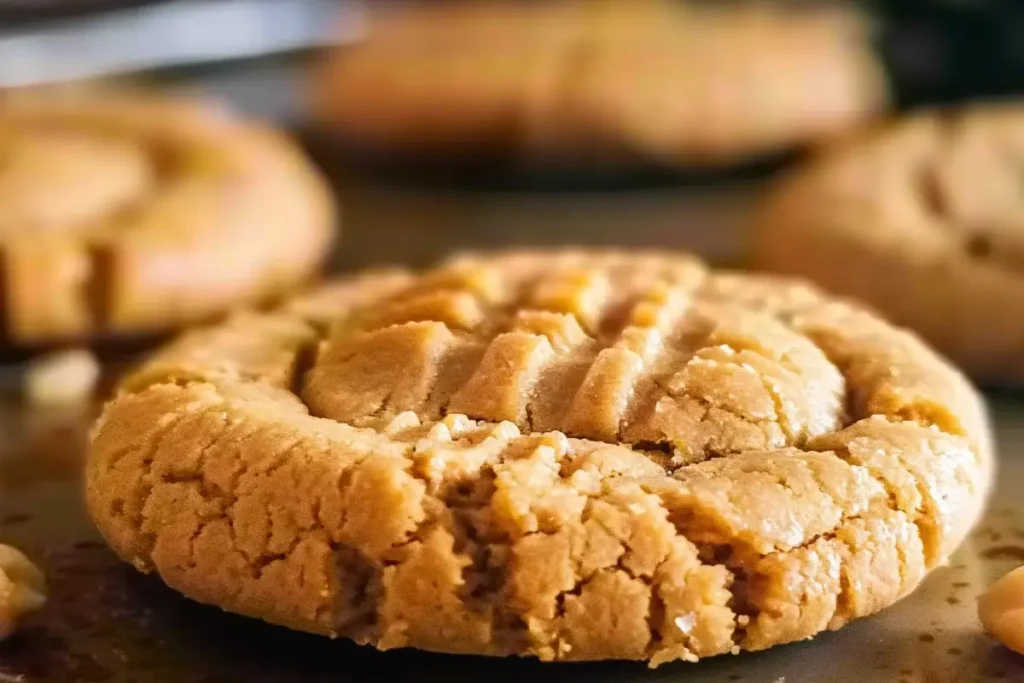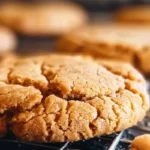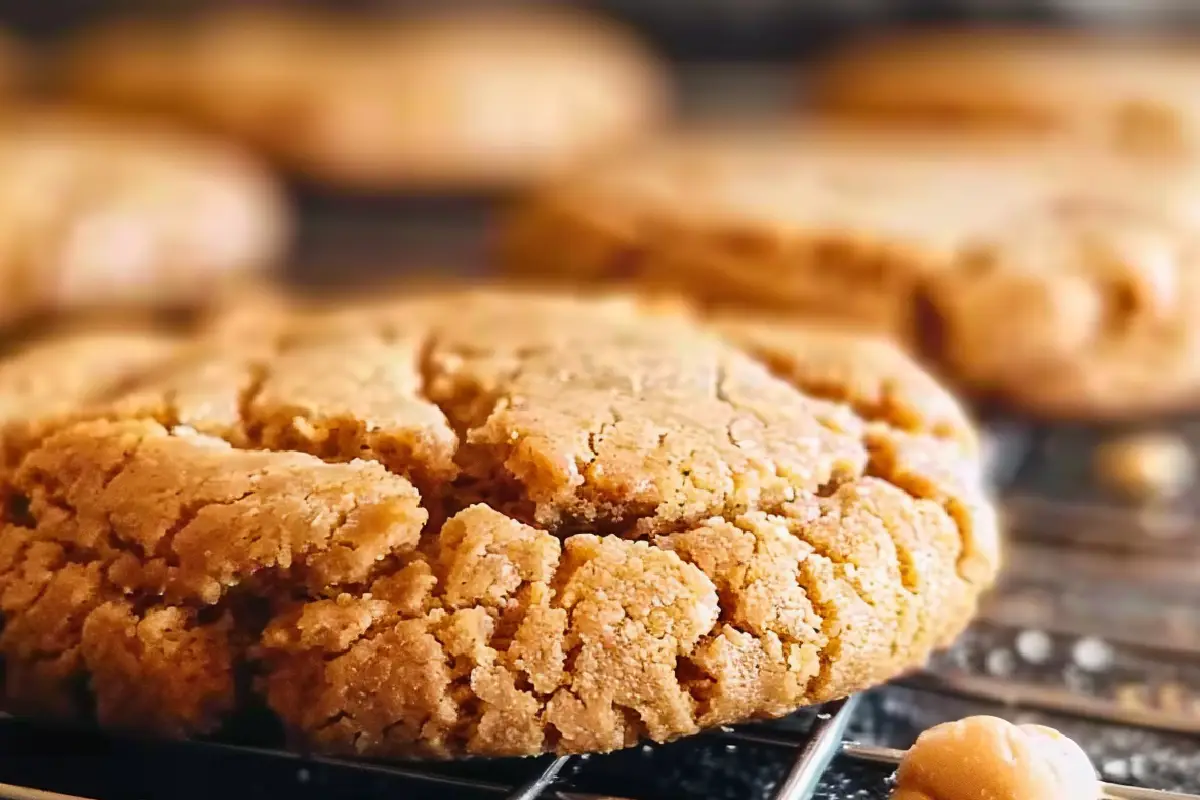Table of Contents: 3 Ingredient Peanut Butter Cookies Falling Apart?
Introduction
There’s nothing worse than pulling a batch of cookies out of the oven—only to watch them crumble apart before they even hit the plate! If your 3 Ingredient Peanut Butter Cookies Falling Apart? has left you frustrated, don’t worry—you’re not alone. These cookies are supposed to be the easiest, most foolproof treat, but sometimes, they just don’t hold together.
The beauty of these cookies lies in their simplicity—just peanut butter, sugar, and an egg. No flour, no butter, just pure peanut buttery goodness. They’re quick, delicious, and perfect for last-minute cravings or gluten-free baking. But when they turn into a crumbly mess, it can feel like a baking fail.
Sound familiar? You might love our 3-Ingredient Peanut Butter Banana Cookies—another no-fuss recipe—but today, we’re fixing the classic. Whether your cookies are too dry, too soft, or just falling apart, we’ve got 5 easy fixes to save your batch. Let’s get those cookies perfect every time!
What Are 3 Ingredient Peanut Butter Cookies?
Who knew three simple ingredients could cause so much drama? 3 Ingredient Peanut Butter Cookies are the ultimate lazy baker’s dream—peanut butter, sugar, and an egg come together in minutes for a chewy, nutty treat. But why do they sometimes crumble like a sandcastle at high tide?
Some say the recipe dates back to the Great Depression when bakers had to make do with minimal ingredients. Others swear it’s just magic (or luck!). Either way, as the old saying goes, “the way to a man’s heart is through his stomach,” and these cookies are a direct path to cookie heaven—when they stay in one piece, that is.
Ready to master them? Let’s fix those crumbly cookies for good!
Why You’ll Love This Recipe

✔ Super Simple – Only 3 ingredients means fewer mistakes (in theory!) and faster baking.
✔ Budget-Friendly – Skip expensive bakery cookies—these cost pennies per batch.
✔ Customizable – Add chocolate chips, a sprinkle of sea salt, or a drizzle of honey for extra flavor.
Compared to our Flourless Peanut Butter Blossoms, these cookies are even easier—no rolling or Hershey’s Kiss needed! Whether you’re a baking newbie or a peanut butter fanatic, this recipe is a must-try.
How to Make 3 Ingredient Peanut Butter Cookies
Quick Overview
- Prep Time: 5 mins
- Cook Time: 10 mins
- Total Time: 15 mins
- Difficulty: Easy
- Yield: 12 cookies
These cookies are fast, foolproof (with our fixes!), and full of peanut butter flavor. No mixer needed—just a bowl and a spoon!
Key Ingredients
- 1 cup creamy peanut butter (not natural—too oily!)
- 1 cup granulated sugar (or brown sugar for chewiness)
- 1 large egg (room temperature works best)
(Optional: ½ tsp vanilla extract or a pinch of salt for extra flavor.)
Step-by-Step Instructions
- Preheat oven to 350°F (175°C) and line a baking sheet with parchment paper.
- Mix ingredients – In a bowl, stir peanut butter, sugar, and egg until smooth.
- Scoop dough – Roll into 1-inch balls and place on the baking sheet.
- Flatten slightly – Use a fork to press crisscross patterns (helps even baking!).
- Bake 8-10 minutes – Let cool 5 mins before moving—they firm up as they cool!
What to Serve With Peanut Butter Cookies
- Classic: A cold glass of milk (obviously!).
- Gourmet Twist: Dunk in melted chocolate or spread with jam.
- Ice Cream Sandwich: Smush between vanilla ice cream for the ultimate treat.
Top Tips for Perfect Cookies
✅ Use processed peanut butter (like Jif or Skippy)—natural peanut butter is too runny.
✅ Don’t overbake! They firm up as they cool.
✅ Chill dough 10 mins if too sticky.
✅ Add 1 tbsp flour if they keep crumbling (shh, we won’t tell!).
✅ Press cookies firmly—loose dough = crumbly cookies.
Storing & Reheating Tips
- Room Temp: Store in an airtight container for up to 5 days.
- Freeze: Layer between parchment paper and freeze for 3 months.
- Revive Stale Cookies: Microwave 5 seconds or warm in a 300°F oven for 2 mins.
FAQs: 3 Ingredient Peanut Butter Cookies Falling Apart?
1. Why are my 3-ingredient peanut butter cookies falling apart?
The most common reasons are:
- Using natural peanut butter (too oily)
- Overbaking (they firm up as they cool!)
- Not enough binding (try adding 1 tbsp flour if needed)
- Skipping the egg (it’s crucial for structure!)
2. Can I use crunchy peanut butter instead of creamy?
Yes! But creamy peanut butter works best for a smooth, uniform texture. If you love crunch, go for it—just know the cookies may be slightly more fragile.
3. Can I make these cookies without sugar?
You can try sugar substitutes like erythritol or monk fruit, but the texture may change. Sugar helps bind the cookies, so without it, they might be more prone to crumbling.
4. How do I fix dough that’s too sticky?
Chill it for 10-15 minutes! This makes it easier to roll into balls. If it’s still sticky, add a sprinkle of flour (just 1 tsp at a time).
5. Can I freeze the cookie dough?
Absolutely! Roll the dough into balls, freeze on a tray, then transfer to a bag. Bake straight from frozen—just add 1-2 extra minutes.
6. Why did my cookies turn out dry?
Overbaking is usually the culprit. Pull them out when they’re just set (they’ll firm up as they cool). Also, check your peanut butter—some brands are drier than others.
Conclusion: 3 Ingredient Peanut Butter Cookies Falling Apart?

There you have it—no more 3 Ingredient Peanut Butter Cookies Falling Apart? disasters! With these 5 easy fixes, you’ll get perfectly chewy, crumble-free cookies every time.
Whether you’re baking for a quick snack, a lunchbox treat, or a last-minute dessert, these cookies are fast, foolproof, and totally delicious. Plus, with the extra tips on storage, substitutions, and troubleshooting, you’re set up for success.
Now it’s your turn! Have you tried these fixes? Do you have a secret trick for perfect peanut butter cookies? Share your baking wins (or funny fails!) in the comments below. And if you loved this recipe, don’t forget to try our 3-Ingredient No-Bake Peanut Butter Bars next—they’re just as easy and twice as addictive!
Happy baking! 🍪✨
Print
Easy 3 Ingredient Peanut Butter Cookies
- Total Time: 15 minutes
- Yield: 12 cookies 1x
- Diet: Gluten Free
Description
“These easy 3 Ingredient Peanut Butter Cookies are soft, chewy, and perfect for when you need a quick sweet fix! Made with just peanut butter, sugar, and an egg, they’re gluten-free and come together in minutes. No mixer required!”
Ingredients
- 1 cup (250g) creamy peanut butter (not natural)
- 1 cup (200g) granulated sugar (or brown sugar for chewiness)
- 1 large egg
(Optional: ½ tsp vanilla extract or pinch of salt for extra flavor)
Instructions
- Preheat oven to 350°F (175°C). Line a baking sheet with parchment paper.
- Mix ingredients: In a bowl, stir peanut butter, sugar, and egg until smooth.
- Shape dough: Roll into 1-inch balls (about 12 cookies) and place on the baking sheet. Flatten slightly with a fork in a crisscross pattern.
- Bake for 8–10 minutes until edges are lightly golden. Let cool 5 minutes on the sheet before transferring.
Notes
- For crispier cookies: Bake 10–12 minutes.
- Sticky dough? Chill for 10 minutes before shaping.
- Storage: Keep in an airtight container for up to 5 days or freeze for 3 months.
- Prep Time: 5 minutes
- Cook Time: 10 minutes
- Category: Dessert
- Method: Baking
- Cuisine: Baking
Nutrition
- Serving Size: 1 cookie
- Calories: 150 kcal
- Sugar: 12g
- Sodium: 60mg
- Fat: 8g
- Saturated Fat: 1.5g
- Carbohydrates: 16g
- Fiber: 1g
- Protein: 4g
- Cholesterol: 15mg
Keywords: 3 ingredient peanut butter cookies, easy peanut butter cookies, gluten-free cookies, no-flour cookies, quick dessert

